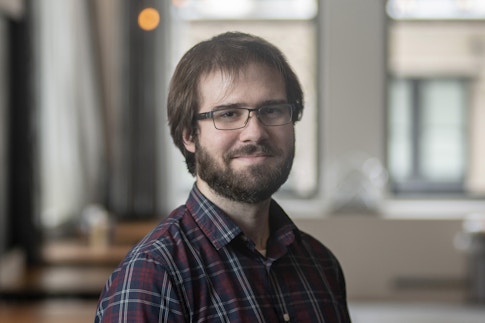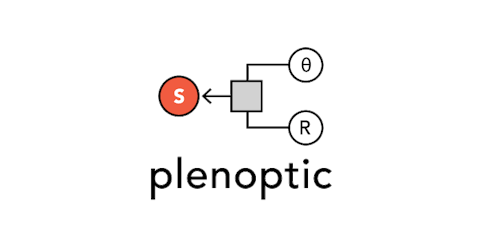New Software Streamlines Neuroscience Research

These days, most scientific research projects require some amount of computer coding to analyze data. While some scientists lament this work, data scientist Billy Broderick truly enjoys it.
Broderick discovered his love for coding outweighed his interest in running experiments while studying neuroscience in graduate school. He liked the challenge of creating new code from scratch and being able to continually test his code at each stage to ensure it wouldn’t fail. Today he focuses solely on coding in his work at the Flatiron Institute’s Center for Computational Neuroscience (CCN) where he develops software that any neuroscientist can use to improve their research.
Broderick joined the CCN as an associate data scientist in 2022. Before that he received a bachelor’s degree in mathematics and neuroscience and a doctorate from New York University’s Center for Neural Science.
Broderick recently spoke to the Simons Foundation about his work and new software package, Plenoptic. The conversation has been edited for length and clarity.
What are you currently working on?
I’m developing a software package that I hope can help streamline visual neuroscience research. In visual neuroscience, researchers are working to understand how our visual system operates. This can include how we recognize faces or how we estimate the spatial orientation of an object. To study this, a researcher might conduct an experiment by showing a subject a bunch of images and recording their neural activity. Using that data, they’ll try to create a model of how the brain processes those images.

The software package I’m working on, called Plenoptic, uses the output of that model to figure out the next step in the scientific process. The software uses the model to ‘synthesize’, or generate, new images that can be used to test the model in a subsequent round of experiments. Ultimately, this can help figure out where the model might be wrong, or where it might be missing pieces.
The underlying idea behind Plenoptic is not new. This approach has long been used by neuroscientists who are studying the visual system or even the auditory system. However, it’s always been done by hand, which requires a lot of time-consuming calculations. Plenoptic automates that work by using a computational process known as ‘automatic differentiation’, which also underlies much of the advances in machine learning over the past decade.
How will this help improve neuroscience research?
Plenoptic can help advance the research process a lot faster. Researchers will no longer have to sit at a desk, do these complex calculations, and come up with these images by hand. More importantly, it will target these images toward places where a model will fail. Increasingly, we’re noticing that when models succeed, they really succeed. But when they fail, they fail in confusing ways that don’t make sense. For example, adding random noise (which a human won’t notice) to an image of a panda can convince a model that the image really contains a gibbon. This means there’s something wrong with the model, but it’s hard to figure out where the issue really is. We hope that the kind of synthesis framework we are using with Plenoptic will help us specifically focus on those kinds of failures. By paying attention to them, we can improve them.
How soon will Plenoptic be available to researchers?
It’s currently freely available online and, right now, I’m working to share it with the wider scientific community. All of our software is open source. Anyone can use it, and anyone can get involved in it. For example, scientists can take our code and remix it for their own purposes, look through it and find bugs, and even work with us to improve it.
Earlier this year we presented a poster at the Vision Science Society Conference in Florida, and now we’re planning out what other conferences we should attend to share our work. We’re also looking into running workshops at the CCN or other external labs where researchers might want to use this software.
Are you working on any other projects at this time?
Another project we have just started is focused on a very standard analysis done in electrophysiology, which is the type of neuroscience where electrodes are used to measure how neurons respond in a brain when it’s responding to a task. This could be when you show an animal an image or have it run a maze. In analyzing this data, researchers have used use a type of analysis called a ‘generalized linear model’ to capture responses (spikes). Despite its ubiquity, there is no standard implementation for this model. As a result, everyone typically writes their own code for it or reuses old code written by someone else in their lab. This lack of standardization makes it hard to compare results from different labs. In terms of coding, electrophysiology has been like the Wild West: Everyone has been doing their own thing for years, and there hasn’t been much success standardizing methods.
We want to fix that. We’re aiming to build software that is easy enough for a second-year graduate student to use on their own. We want it to be both something everyone can use and everyone can trust as a baseline. Often, tool building and maintenance is hard to get support for in science. That’s because there’s often an emphasis on creating new cutting-edge analyses and new algorithms but much less on building and maintaining the basic building blocks so they can be trusted long term. There is typically less funding associated with those types of projects, as well. Our goal with this project as well as with Plenoptic, is to be able to simplify the things most scientists need but consider boring while also providing a really useful tool to help the field. I truly hope this work can streamline research for neuroscientists and aid them on their path to new discoveries.